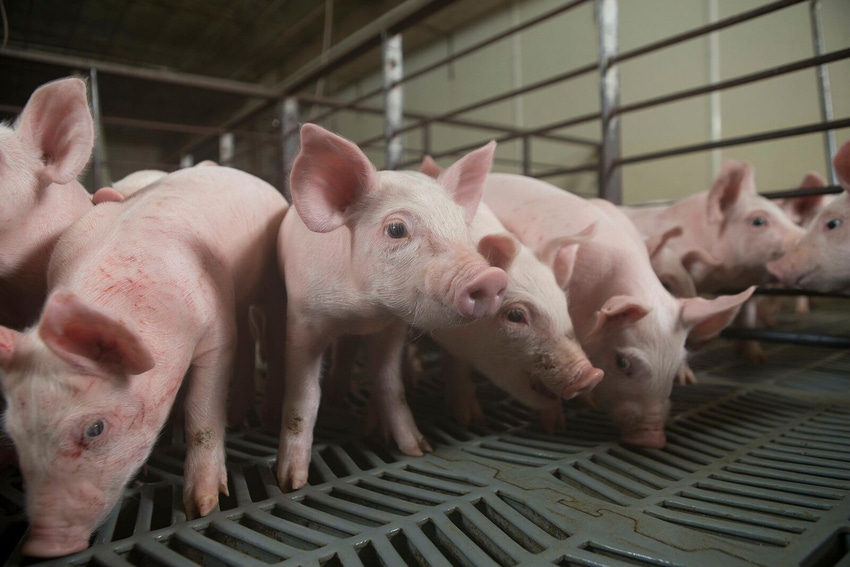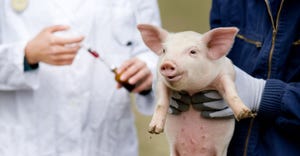SHIC unveils preliminary report of APP lab results
APP is considered an obligate parasite of the respiratory tract, and typically requires close contact between pigs for transmission.
March 16, 2022

In late November 2021, a number of finisher sites in the upper Midwest began reporting outbreaks of respiratory disease with high mortality. Pigs were exhibiting coughing, high fevers and respiratory distress resulting in death loss of up to 51% within a matter of days post-onset. This outbreak affected upwards of nine otherwise unrelated production systems within a narrow geographic radius.
Submissions from affected sites received at Iowa State University Veterinary Diagnostic Lab were diagnosed with Actinobacillus pleuropneumoniae serotype 15. The Swine Health Information Center is supporting additional laboratory analysis of the APP strain involved in the outbreak and, thanks to Alyona Michael, DVM, PhD, DACVP, ISUVDL, here is a preliminary report of results.
The current APP15 outbreak is highly unusual in several respects:
The relatively rarity of APP15 isolation in the United States.
The unusually high mortality for this strain in the US.
Epidemiologic evidence of a high rate of lateral transmission between systems within a narrow geographic radius.
Once the nature and impact of this outbreak were identified, ISUVDL, with funding support from SHIC, rapidly mobilized a tripartite investigatory effort with the following components:
Field-based epidemiologic investigation to characterize outbreak dynamics
Expansion of ISUVDL in-house serotyping capabilities to expedite both retro- and prospective identification of APP15 in ISUVDL submissions
Genetic characterization of APP15 strains recovered from affected sites with comparison to historic isolates
Laboratory work is centering on screening for any genetic shifts in virulence factors that might account for both the high pathogenicity and propensity for lateral transmission of APP15. Preliminary genetic sequencing was performed to characterize primary virulence factors, antibiotic resistance genes and approximate genetic identity between APP isolates from affected herds.
Analysis thus far has confirmed a high degree of homology between strains from the current outbreak but has yet to identify a common historical ancestor. Previously isolated APP15 strains suspected to be endemic to several Iowa systems appear genetically divergent from outbreak isolates. Expanded genetic sequencing will be performed on all 2021-2022 APP15 isolates, with comparison to historical North American strains made possible through collaborative efforts with Marcelo Gottschalk, DVM, PhD, at the University of Montreal.
SHIC Rapid Response Team epi investigations are aimed at identifying the most likely route of APP15 transmission between unrelated sites, a possible geographic and temporal origin for the prevalent strain. More results on that will be reported when the outbreak information has been analyzed.
APP is a non-zoonotic porcine bacterial pathogen. APP is considered an obligate parasite of the respiratory tract, and typically requires close contact between pigs for transmission, with poor environmental survival outside the animal host.
In persistently affected herds, the bacterium is passed from subclinically infected sows to piglets. As colostrum-derived maternal immunity wanes post-weaning and pigs are exposed to stressors and coinfections, APP can spread from the upper respiratory tract to the lung. There, it produces toxins that can cause severe tissue damage, hemorrhage,and death. In animals that survive acute infection, production losses persist in the form of stunted growth and condemned cuts. Lateral transmission of APP via aerosol or human traffic between unrelated sites has been reported, but, is relatively infrequent.
This bacterium can be subclassified into different serotypes (1-19), depending on the molecular composition of the cell wall. Serotypes vary in their pathogenicity, although disease severity varies geographically and depends on a herd's existing immunity and concurrent health challenges. At ISUVDL, the most commonly detected serotypes are APP7 and APP8. Historically, APP15 is associated with high virulence outbreaks in Australia, but is infrequently isolated in the United States and is not typically associated with severe disease in this country.
Moving forward, ISUVDL and SHIC are expanding both field and genomic investigations to determine the origin of this outbreak, and actively prospectively monitoring submissions for high-virulence APP15 persistence in the U.S. swine herd. Questions regarding biosecurity and the ongoing field investigation can be directed via email towards Derald Holtkamp, DVM, MS. SHIC would encourage submission of suspect APP field cases in the area to ISUVDL, directed to the attention of Marcelo Almeida, DVM, MS, PhD or Dr. Michael for expedited processing.
SHIC, launched by the National Pork Board in 2015 solely with Pork Checkoff funding, continues to focus efforts on prevention, preparedness and response to novel and emerging swine disease for the benefit of U.S. swine health.
Source: Swine Health Information Center, which is solely responsible for the information provided, and wholly owns the information. Informa Business Media and all its subsidiaries are not responsible for any of the content contained in this information asset.
You May Also Like



